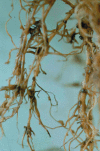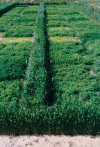Annual Medicago: from a model crop challenged by a spectrum of necrotrophic pathogens to a model plant to explore the nature of disease resistance
- PMID: 16803846
- PMCID: PMC3292268
- DOI: 10.1093/aob/mcl132
Annual Medicago: from a model crop challenged by a spectrum of necrotrophic pathogens to a model plant to explore the nature of disease resistance
Abstract
Background: Annual Medicago spp., including M. truncatula, play an important agronomic role in dryland farming regions of the world where they are often an integral component of cropping systems, particularly in regions with a Mediterranean or Mediterranean-type climate where they grow as winter annuals that provide both nitrogen and disease breaks for rotational crops. Necrotrophic foliar and soil-borne pathogens dominate these regions and challenge the productivity of annual Medicago and crop legume species.
Scope: This review outlines some of the major and/or widespread diseases these necrotrophic pathogens cause on Medicago spp. It then explores the potential for using the spectrum of necrotrophic pathogen-host interactions, with annual Medicago as the host plant, to better understand and model pathosystems within the diseases caused by nectrotrophic pathogens across forage and grain legume crops.
Conclusions: Host resistance clearly offers the best strategy for cost-effective, long-term control of necrotrophic foliar and soil-borne pathogens, particularly as useful resistance to a number of these diseases has been identified. Recently and initially, the annual M. truncatula has emerged as a more appropriate and agronomically relevant substitute to Arabidopsis thaliana as a model plant for legumes, and is proving an excellent model to understand the mechanisms of resistance both to individual pathogens and more generally to most forage and grain legume necrotrophic pathogens.
Figures







Similar articles
-
Jasmonate Signalling and Defence Responses in the Model Legume Medicago truncatula-A Focus on Responses to Fusarium Wilt Disease.Plants (Basel). 2016 Feb 5;5(1):11. doi: 10.3390/plants5010011. Plants (Basel). 2016. PMID: 27135231 Free PMC article.
-
The Medicago truncatula Sugar Transport Protein 13 and Its Lr67res-Like Variant Confer Powdery Mildew Resistance in Legumes via Defense Modulation.Plant Cell Physiol. 2021 Sep 24;62(4):650-667. doi: 10.1093/pcp/pcab021. Plant Cell Physiol. 2021. PMID: 33576400
-
Medicago truncatula as a model for nonhost resistance in legume-parasitic plant interactions.Plant Physiol. 2007 Oct;145(2):437-49. doi: 10.1104/pp.107.097089. Epub 2007 Aug 10. Plant Physiol. 2007. PMID: 17693539 Free PMC article.
-
Natural product biosynthesis in Medicago species.Nat Prod Rep. 2014 Mar;31(3):356-80. doi: 10.1039/c3np70104b. Nat Prod Rep. 2014. PMID: 24481477 Review.
-
Model Legumes: Functional Genomics Tools in Medicago truncatula.Methods Mol Biol. 2018;1822:11-37. doi: 10.1007/978-1-4939-8633-0_2. Methods Mol Biol. 2018. PMID: 30043294 Review.
Cited by
-
A complex genetic network involving a broad-spectrum locus and strain-specific loci controls resistance to different pathotypes of Aphanomyces euteiches in Medicago truncatula.Theor Appl Genet. 2010 Mar;120(5):955-70. doi: 10.1007/s00122-009-1224-x. Epub 2009 Dec 12. Theor Appl Genet. 2010. PMID: 20012740
-
Alfalfa benefits from Medicago truncatula: the RCT1 gene from M. truncatula confers broad-spectrum resistance to anthracnose in alfalfa.Proc Natl Acad Sci U S A. 2008 Aug 26;105(34):12164-9. doi: 10.1073/pnas.0802518105. Epub 2008 Aug 21. Proc Natl Acad Sci U S A. 2008. PMID: 18719113 Free PMC article.
-
Medicago truncatula Oleanolic-Derived Saponins Are Correlated with Caterpillar Deterrence.J Chem Ecol. 2017 Jul;43(7):712-724. doi: 10.1007/s10886-017-0863-7. Epub 2017 Jul 25. J Chem Ecol. 2017. PMID: 28744732
-
Transcriptome analysis of resistant and susceptible Medicago truncatula genotypes in response to spring black stem and leaf spot disease.BMC Plant Biol. 2024 Jul 29;24(1):720. doi: 10.1186/s12870-024-05444-3. BMC Plant Biol. 2024. PMID: 39075348 Free PMC article.
-
Pathotype characterization of Aphanomyces euteiches isolates collected from pea breeding nurseries.Front Plant Sci. 2024 Mar 28;15:1332976. doi: 10.3389/fpls.2024.1332976. eCollection 2024. Front Plant Sci. 2024. PMID: 38606076 Free PMC article.
References
-
- Abdelguerfi A, Chapot JY, Conesa AP. (1988) Contribuution a l'etude de la répartition des luzernes annuelles spontanées en Algerie selon certains facteurs du milieu. Fourragères 11389–106.
-
- Agrios GN. (2004) Plant pathology 5th edn. (Academic Press, Harcourt Brace Jonanovich, Publishers, New York).
-
- Allen DJ, Lenne JM, Wood D. (1998) New encounter diseases and allopatric resistance. Proceedings of the 7th International Congress of Plant Pathology paper 4.1.5.
-
- Andrew CS. (1977) The effect of sulphur on the growth, sulphur and nitrogen concentrations, and critical sulphur concentrations of some tropical and temperate pasture legumes. Australian Journal of Agricultural Research 28807–820.
-
- Andrew WD. (1962) Susceptibility to damping-off in seedlings of Medicago denticulata Willd. and M. minima (L.) Bart. during the early post-emergence period. Australian Journal of Biological Sciences 16281–283.
Publication types
MeSH terms
LinkOut - more resources
Full Text Sources
Other Literature Sources
Miscellaneous

